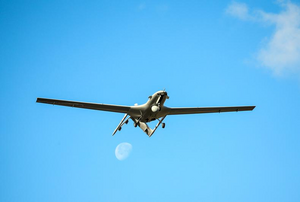MATAR MTBT2 Qarsan
| MTBT2 Qarsan | |
|---|---|

| |
| A Qarsan-1 in flight. | |
| Role | Unmanned combat aerial vehicle |
| National origin | |
| Manufacturer | MATAR |
| First flight | 2009 |
| Introduction | 2012 |
| Primary user | Riysian Arab Aerospace Force |
| Produced | 2012-present |
| Number built | 150 |
| Unit cost |
$5 million (complex)
$1.5 million (single UAV) |
The MTBT2 Qarsan (قرصان, English: "Corsair") is a Riysian medium altitude long endurance unmanned combat aerial vehicle (MALE UCAV) developed originally as a private venture by the Ministry of National Defense's MATAR design bureau. Envisioned as a cheap and persistent tactical UAV with combat capability, reflecting the worldwide drone revolution, the Qarsan is Riysa's first mass-production UCAV and is considered the most successful Riysian MALE UAV.
Aside from the first block of 30 aircraft, the Qarsan can carry 2 (Qarsan-2) or 4 (Qarsan-3) M20H laser-guided bombs, with a range of 8-12 kilometers. It is capable of flying for over 24 hours with a full combat load, or up to 27-28 hours unarmed, and uses many off-the-shelf components to reduce costs and increase production rates. The stealthy carbon fiber airframe and shaping allow it to safely operate on the frontline. However, the Qarsan is currently limited by its directional line-of-sight datalink, which only has a range of about 250 kilometers, extendable to 350 km with a second drone acting as a repeater.
Despite initial skepticism from the Riysian Arab Aerospace Force, the Qarsan has been enthusiastically adopted by the RiyAAF, and is a key component of its airpower doctrine for the future. Around 300 aircraft are expected to be procured by various Riysian services, with 250 alone going to the RiyAAF, and the remainder going to the Riysian Arab Navy and the Air Force Intelligence Directorate. As it does not contain any sensitive technologies, it is actively being marketed for export.
Development
From 1989, the only new UAV system introduced into the Riysian Arab Air Force was Khaddam's Mustakshaf drone, which was first deployed in 1998. The leadership of the Air Force at that time had a conservative view of UAVs, believing that they were only useful for tactical reconnaissance and regarding them of limited value in a conventional war. Though MATAR had been working on a MALE UAV concept ever since 2000 - which would eventually become the MATAR MTBT3 Ababil, a lack of interest in UAVs meant that no new drones had been adopted, and drone development in Riysa had stagnated.
In 2005, a team at MATAR led by Dr. Hikmat Kaftaro, looking to overcome this barrier, came up with a draft for a next-generation UAV design. Made to be cheap and simple to overcome the Air Force's reluctance, it was unarmed.